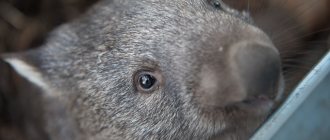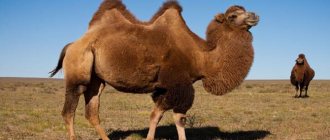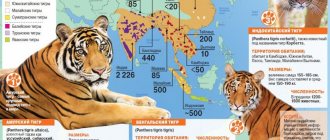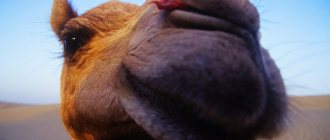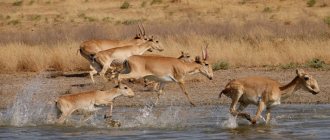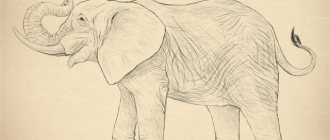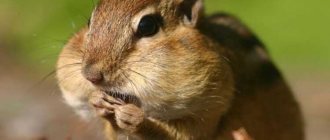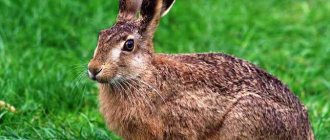1378
1379
1380
1381
1382
1383
1384
1385
1386
The yak (Bos grunniens) is listed as “vulnerable” on the IUCN Red List.
Who is Yak?
The animal yak belongs to the genus of bulls, but differs significantly from them in appearance. The Tibetan yak is a large, tall animal with a long body and short legs. An adult male can reach a length of up to 4.25 meters, a height of 2 meters, and a weight of up to 1 ton. There is a small hump at the withers, which makes the back look sloping. The long horns, curving up to 95 centimeters, are directed in different directions, and the distance between the ends of the horns can be up to 90 centimeters. White markings on the face give this animal a special charm. Sometimes this feature is said to mean that the animal is wearing a mask.
The long hair of this animal covers the legs, chest, belly and sides, forming a so-called “skirt”, and serves as bedding when lying down, and in winter the undercoat also saves from the cold. Thanks to this, Tibetan yaks can simply lie down and rest in the snow and not feel the cold at all. Even the yak's tail is protected by long hair and therefore looks like a horse's. Their coat color varies: from faded black to grayish-brown.
Appearance
Yaks (Bos grunniens) are very large animals with a body more than 4 m long, relatively short legs with wide, rounded hooves and a heavy, low-set head. Old bulls can reach a weight of 1 ton, females are much smaller. At the withers, the yak has a small hump, which makes its back seem very sloping; its head is decorated with sharp curved horns up to 95–100 cm long. Both sexes have horns, they are widely spaced, directed to the sides from the base, and then curved forward and upward. Yaks live in the mountains, at an altitude of 5-6 thousand meters, where it is always cold and the air is very rarefied. Exceptionally warm hair with a thick undercoat helps them survive in extreme conditions. On most of the body the hair is thick and even, but on the legs, sides and belly it is long, shaggy and forms a kind of skirt that reaches almost to the ground (it allows the yak to lie calmly on the snow). The yak's tail is also covered with long, stiff hair and resembles a horse's. Of the sense organs, these mountain bulls have the best developed sense of smell, while vision and hearing are much weaker. Yaks have a narrower muzzle and movable lips than cows and sheep - this helps them pick plants that are inaccessible to domestic animals. On pastures, especially winter ones, the largest plants (dry stems) are usually less nutritious than the short ones picked by the yak. This ability of yaks is very important for them and is the result of biological adaptation to the sparse and very low vegetation of high-mountain deserts and steppes.
What types of yaks are there?
Yaks are distinguished into domestic and wild animals. Wild ones are called “dumb”, and domestic ones are called “grunting”. Because a dissatisfied Tibetan yak can make a sound similar to the grunting of a pig. Domestic yaks are much smaller in size. People have been using these animals for three thousand years to produce meat, wool, and milk. Their milk is very thick and fatty, so they make cheese, sour cream, and butter from it.
But more often, Tibetan yaks are used as a pack animal or used to cultivate land for crops. Yaks are very strong and hardy animals and can easily replace a small tractor for agricultural work.
A domesticated animal is very attached to people. The Tibetan yak allows itself to be led by a ring inserted in its nose.
Local residents take great care of their yaks, although they often use these animals for hard work. But at the same time, they even decorate their own and hang amulets made of embroidered ribbons, beautiful tassels and pom-poms on them.
The riding yak is a faithful friend of the Tibetan. A self-respecting man will not sit astride a yak again, he will lead it.
Grunting yaks are crossed with other species of animals from the bull family. Females can then give birth to offspring, but for some reason male “khainaki” hybrids are sterile. The Dzo or male Hainak is a common animal in Tibet that has the stamina of a Tibetan yak and the ability to live at low altitudes.
Wild Tibetan yaks have recently been climbing higher and higher, where there are no places developed by humans. Sometimes they rise to a height above 6 thousand meters above sea level. Tibetans call them drong. Such yaks can be dangerous for people, especially when injured. The animal rushes at the offender and tries to finish him off. An enraged male Tibetan yak is menacing, strong, ferocious and well armed with strong and long horns and hooves.
An excellent sense of smell allows him to notice the enemy from afar. Their hearing and vision organs are less developed. In case of danger, like many of this species of animals, wild Tibetan yaks stand in a circle and protect babies and weak individuals inside it.
Herds of Tibetan yaks reach 10-12 heads. Then, as in the time of the Przhevalsky herd, these animals reached hundreds, or even thousands. Therefore, wild yaks are now listed in the Red Book.
Wild Tibetan yaks are now quite a rare animal, but nevertheless they can be found in Tibet and the Himalayas: in China and Nepal.
Lifestyle and reproduction
Yaks live in families or small herds of 10-12 animals, old males live alone. During the rut, fierce fights occur between males, during which rivals try to hit each other in the side with their horns. Gestation in yakhs lasts 258 days, which is 30 days shorter than in domestic breeds of cattle. Shortened intrauterine development and low birth weight of newborns are, in all likelihood, adaptations to living in extreme conditions of high mountains. Before calving, the yak leaves the herd and finds a secluded and dry place where the egg is born. Immediately after birth, the mother intensively licks the baby, which is very important for quickly restoring normal blood circulation and breathing at low temperatures. After only 20-25 minutes, the newborn little egg gets to its feet and begins to suck milk, and after 3-4 days it is able to follow its mother for quite long distances in search of food. The calf is not separated from its mother for about a year. Adult yaks are fierce and very strong; wolves dare to attack them only in a large pack in deep snow. But if this does happen, the yaks take up a circular defense and hide the cubs inside the circle.
Where do yaks live?
The homeland of yaks is Tibet, where they have lived for about ten thousand years. Tibet is an amazing place, nicknamed the “Roof of the World”. And although the high mountains and clear lakes amaze with their beauty, the thin air here makes it difficult to move, much less transport any cargo. Horses and other animals familiar to the plain are not able to work in such conditions, and therefore the people living on Tabet domesticated Tibetan yaks precisely for the purpose of transporting goods.
Yaks are ideally suited for life in the mountains; these animals are unpretentious to food and are well protected from the cold. The yak is practically unaffected by the rarefied high-mountain air and it easily carries a load of up to 150 kilograms along mountain paths, where two people can hardly pass each other. And today, as in ancient times, Tibetan yaks carrying heavy loads help people out.
In the mountainous regions of Mongolia, Tibetan yaks are kept in all families; they are used for almost all household needs. And although many people now have cars and motorcycles, yaks have not been removed from the accounts. Yaks transport all cargo, at any time of the year and in any weather, the yak is not a car and will not get stuck anywhere.
One of the professions of Tibetan yaks in mountain villages is water transport. Typically, villages are located above rivers and therefore water has to be transported several hundred meters uphill. Usually there are no water pipes, as well as roads, and yaks and khainaks are accustomed to this. Hainaks, accustomed to carrying water, work all year round along the same route: village - river, river - village. There is no need to drive them, they know the way themselves. Yak water carrier often has more than one family. This animal gets so used to its route that it is often sent alone to the river, the people there fill its flasks with water, and then it goes to the village itself.
In many villages in Tibet, if they want to go somewhere or send their children to visit, they call a taxi, only there are no cars there, and the role of a taxi is performed by Tibetan yaks.
With the onset of summer, hundreds of caravans of Khaynaks and Tibetan yaks move across the steppe, carrying the property of pastoralists migrating to summer pastures. Cattle breeders are nomads and are forced to carry all their property with them, which they usually transport on yaks. Often such a caravan consists of a dozen or more animals harnessed to carriages.
The nomadic tribes of Tibet cannot do without Tibetan pack yaks; all property and even children are transported on these animals.
The ancient custom of the Tibetans to send their bride riding on a Tibetan yak still exists today. The yak is a kind of dowry for a girl.
Yaks are rightfully the hallmark of the Himalayas. In Nepal, the most famous mountaineering country, not a single expedition to the mountain peaks is complete without yaks. It is on Tibetan yaks that all the equipment of climbers going to climb Everest, the highest mountain peak, is carried. Yaks are the only animals capable of carrying cargo to the base camp on Everest, at an altitude of 5400 meters.
Tibetan yaks were widely distributed in Asian countries and the North Caucasus. It has been noted that these animals can very well predict earthquakes and climate changes. They refuse to eat until about a few hours before the earthquake and begin to worry.
Domestication
Yaks were domesticated by humans already in the first millennium BC. They carry luggage and ride on horseback. Strong and resilient, yaks easily carry packs weighing 120-140 kg along mountain trails and snowy passes. Man also uses the meat, milk and wool of these animals. Yak milk is very thick, rich in protein and fat (its fat content ranges from 3.8% to 10.8%). About 3 kg of wool is sheared per year from one yak, from which very warm blankets and ropes are made. In some countries, even the droppings of these animals are not wasted, but are used as fuel.
What do yaks eat?
Living in harsh mountainous areas with very sparse vegetation, yaks are accustomed to any plant food. In addition, yaks eat very little; the volume of food they eat is only 1% in relation to their body weight, while other animals eat about 3% of their body weight per day. Compared to livestock, yaks have an unusually large stomach, which allows them to eat more food at a time and take longer to digest it. As a result, the maximum amount of nutrients is extracted from roughage.
Since yaks are herbivorous ruminants, their main diet in summer consists of grasses, sedges and leaves of shrubs, in winter it is mosses and lichens. Tibetan yaks constantly migrate seasonally. In the summer they go to higher mountain pastures, where the grass cover lasts longer and they can eat more succulent grass. In winter, the yaks descend into the low-lying plains, where the vegetation remains green until late autumn. When the grass disappears, the yaks feed on mosses and lichens, which they dig out from under the snow and tear off from the stones with their rough tongues. In addition, in winter, when there are problems with water, these animals quench their thirst by eating snow without any health problems. Yaks living at home are fed hay and barley in winter. An interesting fact is that yaks themselves, unlike livestock, do not smell and their manure is practically odorless.
Reproduction and mating season of bulls
Males are twice as large as females and weigh from 0.95 to 1 ton. The female carries the fetus for 9 months. The cubs stay with their mother for up to a year. Puberty occurs at 6-8 years of age. The yak lives on average 25-30 years . Aggressive, especially during the mating season, which occurs in September-October. At this time they join the herd of cows. Heavy fights occur between males.
The yak uses its horns to pierce its opponent sideways, and this distinguishes it from other bovids. When attacking, the male holds his head high and develops a horse-like tail. He doesn’t know how to roar or moo, but only grunts when he’s angry. This applies to domestic breeds; wild yaks are silent. During pregnancy, the male leaves the pregnant female. Domesticated animals are well trained and are found in circuses.
Sports yaks
Today, Tibetan yaks are used not only for work, but often for entertainment. Despite their external clumsiness, these animals can run quite quickly and in Mongolia, yaks began to be used for various sports competitions. The most popular are yak races, in which everyone participates and an expensive prize is awarded to the winner.
Riding yaks they organize something like an American rodeo. Such events are very popular and attract many spectators. Amateurs from many countries, even cowboys from America, come to such large shows.
A popular sport in Tibet is yak polo, in which participants play field hockey while riding Tibetan yaks, the so-called Sarlagan polo.
Interesting Facts
Yak wool is widely used by the inhabitants of Tibet; it is noteworthy that the harness in which the yaks are harnessed is woven from the wool of the animal itself.
Yaks are unpretentious eaters.
Yaks are incredibly resilient animals. There are cases when they met old bulls with bullet wounds in the head and chest, and, despite this, they continued to run across the expanses of mountain fields.
If you find an error, please select a piece of text and press Ctrl+Enter.
Yaks in the culture of Tibetan peoples
The Yaks are greatly reflected in the culture of the Tibetan peoples. Images of Tibetan yaks are present in many paintings. Flying yaks are one of the fabulous themes of the paintings of the famous Chinese artist Wang Yi Guang.
Since ancient times, figures of Tibetan yaks can be seen in miniatures that tell about the hard work of peasants and the help of this animal in the household. Nowadays, yaks are even depicted on postage stamps. A whole series of stamps dedicated to this animal has been issued in Kyrgyzstan.
And what beautiful souvenirs you can bring from a trip to Tibet! Figurines of Tibetan yaks, knitted woolen products, food products, ropes made of yak wool. Yak fur is combed, not sheared. Due to the fact that wool does not absorb water, the products are silky, soft, warm and light. Woolen products have their own unique characteristics: they never cause allergies, do not have “pillings” when worn and washed, and relieve painful symptoms of the disease.
Tibetan yaks are still the most popular animals in Tibet. Even with modern means of transportation such as cars, motorcycles and ATVs, snowmobiles, yaks are used as riding animals. Some models use them for their photo shoots.
Of course, this is only a small part of the information about these beautiful animals. But we will be glad if our story interests you and you want to know more about the Tibetan yak and its habitat. It is best to visit these places and get acquainted with the brightest representative of the animal world of Tibet.
bison
In the Middle Ages, bison lived in Central and Eastern Europe. They preferred forests, deciduous, coniferous, mixed. A distinction was made between the Caucasian species of bison and animals of the plains. Bison had high endurance. In appearance they are similar to bison, but their hair is thicker and spread over the entire body. The skin and meat of the animals attracted hunters.
In the 20s of the 20th century. Wild bison have completely disappeared. Only the individuals that were in zoos remained. Selectors began to engage in breeding and breeding of livestock.
Gradually, some individuals were released into the wild. Currently, free herds of bison are located in Belovezhskaya Pushcha. Their population barely exceeds 5 thousand.
- The animals are large. They have a massive chest: girth 246 cm. Height at withers 188 cm. Body length up to 3 m. The neck is short with a large hump, covered with thick long hair. The head is short, low set. This gives the animal a menacing appearance. The horns are longer than those of bison. They form a crescent with an internal curve. Along the bend, their length reaches 65 cm.
- The Belovezhsky bison weighs 1.2 tons. The cow weighs 700 kg. The calf weighs 24-30 kg: bull calves are larger than heifers. The udder of females is small. It's unnoticeable. It is hidden in the folds of the skin. After calving, it increases slightly and 4 teats protrude.
- Bison have good hearing and sense of smell. Their vision is slightly less developed.
- Thick fur allows animals to sleep in the snow. In severe frosts, they hide in the thickets of the forest.
- The herd of bulls lives separately from the herd of cows and young animals. They connect only during the mating period.
There is a bison distribution program. Currently, a small population is located in the Vologda region, near Smolensk, Kaluga. Animals are resettled from nurseries in Poland, Germany, Spain, the Baltic states, and Slovenia.
